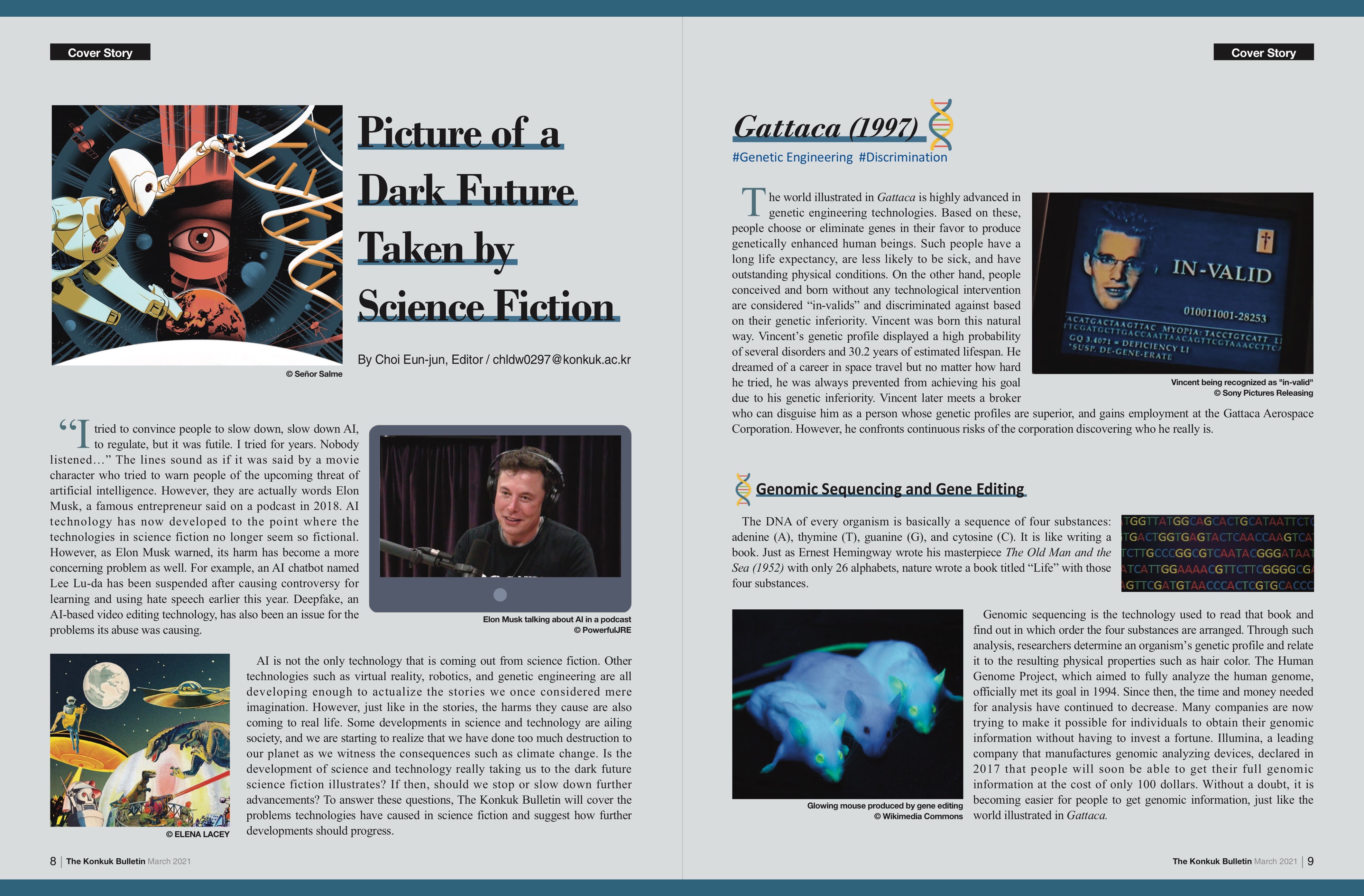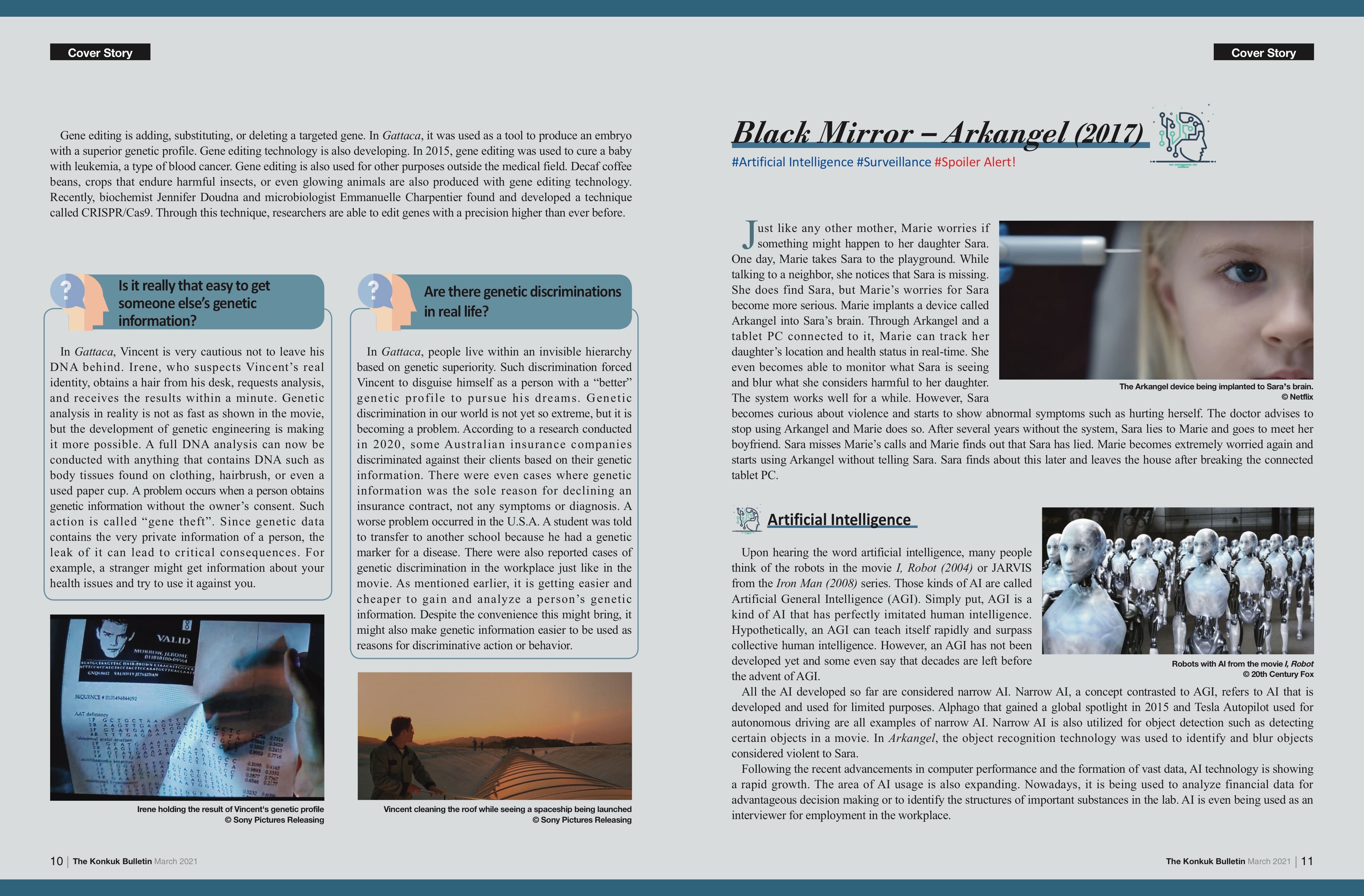



"I tried to convince people to slow down, slow down AI, to regulate, but it was futile. I tried for years. Nobody listened…” The lines sound as if it was said by a movie character who tried to warn people of the upcoming threat of artificial intelligence. However, they are actually words Elon Musk, a famous entrepreneur said on a podcast in 2018. AI technology has now developed to the point where the technologies in science fiction no longer seem so fictional. However, as Elon Musk warned, its harm has become a more concerning problem as well. For example, an AI chatbot named Lee Lu-da has been suspended after causing controversy for learning and using hate speech earlier this year. Deepfake, an AI-based video editing technology, has also been an issue for the problems its abuse was causing.
AI is not the only technology that is coming out from science fiction. Other technologies such as virtual reality, robotics, and genetic engineering are all developing enough to actualize the stories we once considered mere imagination. However, just like in the stories, the harms they cause are also coming to real life. Some developments in science and technology are ailing society, and we are starting to realize that we have done too much destruction to our planet as we witness the consequences such as climate change. Is the development of science and technology really taking us to the dark future science fiction illustrates? If then, should we stop or slow down further advancements? To answer these questions, The Konkuk Bulletin will cover the problems technologies have caused in science fiction and suggest how further developments should progress.
Gattaca (1997)
#Genetic Engineering #Discrimination
The world illustrated in Gattaca is highly advanced in genetic engineering technologies. Based on these, people choose or eliminate genes in their favor to produce genetically enhanced human beings. Such people have a long life expectancy, are less likely to be sick, and have outstanding physical conditions. On the other hand, people conceived and born without any technological intervention are considered “in-valids” and discriminated against based on their genetic inferiority. Vincent was born this natural way. Vincentʼs genetic profile displayed a high probability of several disorders and 30.2 years of estimated lifespan. He dreamed of a career in space travel but no matter how hard he tried, he was always prevented from achieving his goal due to his genetic inferiority. Vincent later meets a broker who can disguise him as a person whose genetic profiles are superior, and gains employment at the Gattaca Aerospace Corporation. However, he confronts continuous risks of the corporation discovering who he really is.
Genomic Sequencing and Gene Editing
The DNA of every organism is basically a sequence of four substances: adenine (A), thymine (T), guanine (G), and cytosine (C). It is like writing a book. Just as Ernest Hemingway wrote his masterpiece The Old Man and the Sea (1952) with only 26 alphabets, nature wrote a book titled “Life” with those four substances.
Genomic sequencing is the technology used to read that book and find out in which order the four substances are arranged. Through such analysis, researchers determine an organismʼs genetic profile and relate it to the resulting physical properties such as hair color. The Human Genome Project, which aimed to fully analyze the human genome, officially met its goal in 1994. Since then, the time and money needed for analysis have continued to decrease. Many companies are now trying to make it possible for individuals to obtain their genomic information without having to invest a fortune. Illumina, a leading company that manufactures genomic analyzing devices, declared in 2017 that people will soon be able to get their full genomic information at the cost of only 100 dollars. Without a doubt, it is becoming easier for people to get genomic information, just like the world illustrated in Gattaca.
Gene editing is adding, substituting, or deleting a targeted gene. In Gattaca, it was used as a tool to produce an embryo with a superior genetic profile. Gene editing technology is also developing. In 2015, gene editing was used to cure a baby with leukemia, a type of blood cancer. Gene editing is also used for other purposes outside the medical field. Decaf coffee beans, crops that endure harmful insects, or even glowing animals are also produced with gene editing technology. Recently, biochemist Jennifer Doudna and microbiologist Emmanuelle Charpentier found and developed a technique called CRISPR/Cas9. Through this technique, researchers are able to edit genes with a precision higher than ever before.
Is it really that easy to get someone else’s genetic information?
In Gattaca, Vincent is very cautious not to leave his DNA behind. Irene, who suspects Vincent’s real identity, obtains a hair from his desk, requests analysis, and receives the results within a minute. Genetic analysis in reality is not as fast as shown in the movie, but the development of genetic engineering is making it more possible. A full DNA analysis can now be conducted with anything that contains DNA such as body tissues found on clothing, hairbrush, or even a used paper cup. A problem occurs when a person obtains genetic information without the owner’s consent. Such action is called “gene theft”. Since genetic data contains the very private information of a person, the leak of it can lead to critical consequences. For example, a stranger might get information about your health issues and try to use it against you.
Are there genetic discriminations in real life?
In Gattaca, people live within an invisible hierarchy based on genetic superiority. Such discrimination forced Vincent to disguise himself as a person with a “better” genetic profile to pursue his dreams. Genetic discrimination in our world is not yet so extreme, but it is becoming a problem. According to a research conducted in 2020, some Australian insurance companies discriminated against their clients based on their genetic information. There were even cases where genetic information was the sole reason for declining an insurance contract, not any symptoms or diagnosis. A worse problem occurred in the U.S.A. A student was told to transfer to another school because he had a genetic marker for a disease. There were also reported cases of genetic discrimination in the workplace just like in the movie. As mentioned earlier, it is getting easier and cheaper to gain and analyze a person’s genetic information. Despite the convenience this might bring, it might also make genetic information easier to be used as reasons for discriminative action or behavior.
Black Mirror – Arkangel (2017)
#Artificial Intelligence #Surveillance #Spoiler Alert!
Just like any other mother, Marie worries if something might happen to her daughter Sara. One day, Marie takes Sara to the playground. While talking to a neighbor, she notices that Sara is missing. She does find Sara, but Marie’s worries for Sara become more serious. Marie implants a device called Arkangel into Sara’s brain. Through Arkangel and a tablet PC connected to it, Marie can track her daughter’s location and health status in real-time. She even becomes able to monitor what Sara is seeing and blur what she considers harmful to her daughter. The system works well for a while. However, Sara becomes curious about violence and starts to show abnormal symptoms such as hurting herself. The doctor advises to stop using Arkangel and Marie does so. After several years without the system, Sara lies to Marie and goes to meet her boyfriend. Sara misses Marie’s calls and Marie finds out that Sara has lied. Marie becomes extremely worried again and starts using Arkangel without telling Sara. Sara finds about this later and leaves the house after breaking the connected tablet PC.
Artificial Intelligence
Upon hearing the word artificial intelligence, many people think of the robots in the movie I, Robot (2004) or JARVIS from the Iron Man (2008) series. Those kinds of AI are called Artificial General Intelligence (AGI). Simply put, AGI is a kind of AI that has perfectly imitated human intelligence. Hypothetically, an AGI can teach itself rapidly and surpass collective human intelligence. However, an AGI has not been developed yet and some even say that decades are left before the advent of AGI.
All the AI developed so far are considered narrow AI. Narrow AI, a concept contrasted to AGI, refers to AI that is developed and used for limited purposes. Alphago that gained a global spotlight in 2015 and Tesla Autopilot used for autonomous driving are all examples of narrow AI. Narrow AI is also utilized for object detection such as detecting certain objects in a movie. In Arkangel, the object recognition technology was used to identify and blur objects considered violent to Sara.
Following the recent advancements in computer performance and the formation of vast data, AI technology is showing a rapid growth. The area of AI usage is also expanding. Nowadays, it is being used to analyze financial data for advantageous decision making or to identify the structures of important substances in the lab. AI is even being used as an interviewer for employment in the workplace.
Can AI be used for surveillance purposes?
AI has been used in several areas during the COVID-19 pandemic. One example was using it to find people with high temperatures automatically. Such applications helped prevent the spread of COVID-19 by examining and processing vast amounts of body temperature information in the public. However, the same technology can be easily abused by using it for excessive surveillance. For example, China currently has over 20 million AI cameras used to automatically identify people in the public while gathering information about them. While the Chinese government states that the use of AI cameras is to maintain public order, people are concerned about the usage of their information. China is not the only place with such utilization of AI for surveillance. According to research conducted in 2019, at least 75 countries were using AI-utilizing surveillance. Although such surveillance might be effective in ensuring public security, an individual’s privacy can be infringed, just like in the case of Sara.
Are there other threats caused by AI?
In many SF stories, advanced AI attacks and tries to dominate humanity for many purposes. Fortunately, as mentioned earlier, no AI has yet achieved the intelligence to develop such hostility towards us. There are also controversial opinions on whether AI would decide to attack humankind even if it does obtain higher intelligence. However, the abuse of AI is already a threat. One of them is Deepfake. As mentioned earlier, Deepfake is an AI-based video editing technology. The products of Deepfake are highly realistic to the point that the film industry is considering using the technology. The problem of Deepfake, however, is that it can easily be used for deception since it is easier to use compared to traditional photo editing skills. According to research conducted in 2019, 96 percent of a total of 14,698 Deepfake videos were pornographic and nonconsensual. An online petition has been filed with over 375,000 participants earlier this year in Korea asking for action about this problem. People also worry that Deepfake videos might be abused in politics and distort important facts. In 2018, a video of former U.S. president Barack Obama talking about the contents on the Internet was uploaded on YouTube. However, the person in the video was an edited version imitating the appearance of Barack Obama with an impersonated voice by another person. Fortunately, the video was not used for deception and only warned how careful people should be in trusting contents on the Internet.
The Day After Tomorrow (2004)
#Climate Change #Thoughtless Development
Dr. Jack Hall is a climatologist. As he was investigating the ice cores in the Antarctic, he figures out that there will be a severe climate change. He discusses his findings at a UN conference. He warns that the melting ice shelves will eventually cause an ice age. Not long after, abnormal weathers such as hail the size of a bowling ball and unprecedented severe storms occur in several places around the Earth. Dr. Hall realizes that his theory is really occurring and convinces the vice president for an immediate evacuation. However, the vice president ignores his request. Ice age hits New York and everything starts to freeze in an instant. Giving up hope for the northern part of the nation, the president decides to evacuate people in the southern part of America to Mexico.
Climate Change
Unlike the movies mentioned earlier, The Day After Tomorrow focuses more on the catastrophic results caused by thoughtless developments, which is climate change in the movie. Climate change is the immense change of climate due to global warming resulted from greenhouse gases emitted by people. It is currently one of the biggest problems that many experts and global leaders are trying to cope with. After several climate shifts, Earth’s temperature has stabilized and changed within a 1°C range1) for the last 10,000 years. However, the imprudent use of fossil fuels and the resultant emission of greenhouse gases has broken this stability. The temperature has risen by 1°C since the industrial revolution and is expected to rise 3-5°C more by the end of the century if no measures are taken against it.
Why is climate change such a big problem?
Rise of sea levels
One of the most mentioned impacts of climate change is the rise of sea levels. Due to the rise in temperature, the speed of ice sheets melting is dramatically increasing. The sea level has risen by 1.8 centimeter since 1990. This might not seem as much of an increase, but the figure matches with the worst-case scenario the Intergovernmental Panel on Climate Change (IPCC) has demonstrated. According to the IPCC, sea levels will rise by 17 centimeter by the end of the century and over 16 million people worldwide will have to endure annual storms and tsunamis.
Extreme weather events
Climate change influences a wide range of intensive events to occur. Due to the increase in temperature, climate change results in extreme droughts. Some experts assume the severity of the 2019-20 Australian bushfire to be the result of climate change. Climate change also results in severe floods. While Australia has been suffering from severe bushfires, heavy rain and floods were occurring across the Indian Ocean in Africa. The floods were also assumed to be the result of climate change increasing the evaporation of sea waters near the African coast.
What We Should be Doing
Some dark futures in science fiction are not really a fiction anymore. Does that mean we should stop all developments of science and technology? If someone were to reach such a conclusion, they would be attributing the cause of the problem inaccurately. The problems mentioned so far are not caused by science and technology itself, but rather the users of the knowledge, us. Therefore, in order to avoid the tragic world illustrated in science fiction, we need to make sure we are developing science and technology in a sustainable direction. Specifically, we should start establishing social policies, start considering the aftermath beforehand, and start cooperating globally to solve the problems.
Establishing social policies
The most important effort is establishing social policies that would ensure the safe development and use of technology. Such policies include law legislation and an international declaration. In the case of genetic engineering introduced through Gattaca for example, both efforts are being made. In 1997, UNESCO declared through the “The Universal Declaration on the Human Genome and Human Rights” that no one shall be subjected to discrimination based on genetic characteristics. In the U.S.A., the Genetic Information Nondiscrimination Act has been legislated to protect people from genetic discrimination in both health insurance and employment by ensuring the confidentiality of genetic information. More countries are also following the spirit of the UNESCO declaration and establishing social policies to ensure it. Science and technology will be fully beneficial to us only when such policies ensure a safe use of them.
Considering the aftermath beforehand
In some cases, social policies about the use and development of a technology are not fully established. For example, policies regarding the use of AI technology are still in the early stage of establishment. One reason for this is because we do not fully understand the potential damages the technology might cause. However, discussions on the policies should start as technology develops. The catastrophic situation described in the movie The Day After Tomorrow resulted because people did not consider the impacts of their decision before deciding to aggressively use fossil fuels. This sadly applies to reality as well. For example, cars were invented in 1886 but laws regarding the use of seatbelts were first legislated in 1970. Actions were taken only after countless deaths alerted people to take action. If we had considered the impacts of their actions beforehand, there would have been more time to tackle the problem or maybe have no problem to deal with.
Fortunately, we learn from our mistakes. The Conference on Neural Information Process Systems (NeurIPS) is globally acknowledged in the fields of AI. At their 2020 conference, NeurIPS established a new qualification policy for the papers they accept. The new policy demanded papers to include a general evaluation of the positive, negative, and social impact of the introduced work. Through such actions, NeurIPS took a step closer to a safer development of AI before more problems could happen. Coping with the problem is not good enough. A safe development requires guidelines for its uses.
Global cooperation
Problems are becoming more and more global. What used to be a local disease now grows to a pandemic, and what used to be a regional finance problem now grows to a worldwide recession. This is because a global network has been formed due to advancements in transportation and communication. Problems caused by the development of science and technology are also worldwide. The commercialization of genetic engineering or AI will spread across nations and the problems will also be a global problem as it was for fossil fuels and climate change. Such global problems need a global cooperation in order to cope with them. Fortunately, this is already happening. The emission of CO2, a major greenhouse gas, must be reduced to zero in order to tackle climate change. However, CO2 is emitted through the use of fossil fuels which is the major source of energy. Although such reduction seems to be unprofitable in the short term, national leaders are promising to completely reduce the emission of CO2 and invest more in the development of alternative energy. Humanity will be able to create a better future only if people give up their personal interests and start cooperating for a bigger goal.
Conclusion
A captain excitedly prepares for his adventure, imagining the treasures he will find
and the beautiful lands he will reach. At the same time, he fears the destructive wind
and waves of the sea. It is natural for a captain to fear the sea, but a wise captain uses his fear to pursue a thorough preparation. This is the same for us. We have a
beautiful goal: a happier life for everyone. Without a doubt, there will be numerous
difficulties lying between us and our goal. We might even drive into the wrong path.
It is natural for us to fear the hardships, but we should be wise and use our fear as
guidelines for a thorough preparation. In this regard, science fictions serve as an
excellent guideline for our preparation. We should not give up our goal worrying
about the dark future they illustrate, but rather prepare our journey trying our best to
avoid such futures.

